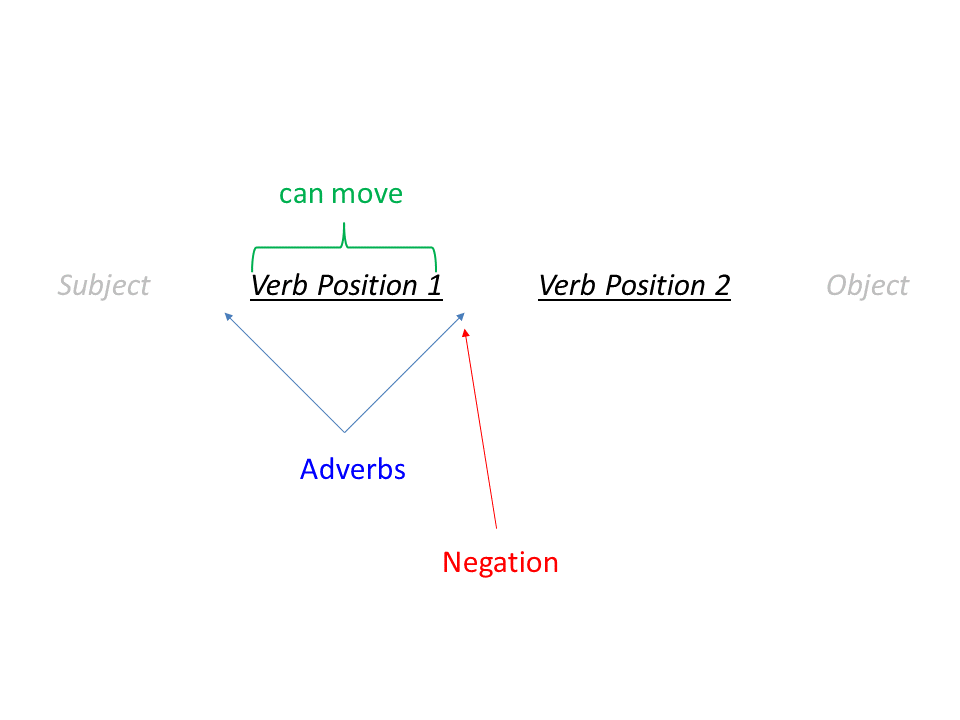
From the previous three examples, we can figure out the following descriptive rules for English:
The latter two rules are examples of a process called do-support: using the word do to support grammatical functions. (Do itself, in these sentences, doesn't mean anything; it's just added there to fill the role of an auxiliary verb.) This is claimed to be a typologically rare feature of English—i.e., supposedly, few other languages have a process like this.
What we see here is that auxiliary verbs work differently than main verbs. In fact, we could argue that the structure of a sentence includes two different positions (or "slots") where verbs can go:
| Subject | Verb position 1 | Verb position 2 | Object |
We can assume that auxiliaries go in "position 1" and main verbs go in "position 2". We can further assume that many things (like negation, ability for verbs in this position to move, and adverb placement) are associated with position 1 and not with position 2 (as shown in the image below); this would explain all the differences we've seen between main verbs and auxiliary verbs.

In generative syntax, it is widely assumed that these different types of verb form different types of phrases. A main verb (plus its object complement, if it has one), forms a Verb Phrase (VP), like eats pie: in this phrase, eats is the head and pie is the complement. (Remember the difference between heads and complements, discussed in the "Basics of syntax" module). On the other hand, an auxiliary verb combines with a verb phrase to create a new kind of phrase, called an Inflectional Phrase, or IP (in some theories this is called a Tense Phrase, or TP). The head of an Inflectional Phrase is an auxiliary verb, and the complement is an entire Verb Phrase. This is illustrated in the trees below: "eating" combines with "pie" to form a Verb Phrase, and then "are" combines with that Verb Phrase to form an Inflectional Phrase. (The two trees are identical, except that the second one explicitly shows the labels for the different types of phrases.)
![Syntax tree for [ [we] [are [eating pie] ] ]](ip2.png)
![Syntax tree for [ [we] [are [eating pie] ] ]](ip3.png)
The Verb Phrase is where the meaningful "content" of the sentence comes from, and thus that's where main verbs appear. On the other hand, the Inflectional Phrase is where functional stuff (such as tense, agreement, etc.) is introduced, and that's why auxiliary verbs are introduced there. Importantly, the Inflectional Phrase is also the place where things like negation, adverbs, etc., are hosted.
Crucially, in strong versions of generative syntax theory, it is assumed that the Inflectional Phrase is present in every sentence—even if you don't "see" it. In sentences that don't have an auxiliary verb, an Inflectional Phrase is still present in the grammatical structure (because the things it introduces, like tense, are necessary parts of a sentence), it's just not pronounced (the head of the Inflectional Phrase is silent):
![Syntax tree for [ [we] [___ [eat pie] ] ]](ip4.png)
What we see in English is that main verbs are stuck in the Verb Phrase. We know that because main verbs can't do all the things auxiliary verbs do—e.g., they can't have an adverb or negation directly after them. In sentences that need those things, we often create a fake auxiliary verb, do, in the necessary position (the head of the Inflectional Phrase) so it can do all that stuff.
You don't need to submit anything for this activity, but make sure you understand the concept of the Inflectional Phrase. In the next activity we will examine how another language's main and auxiliary verbs work differently from English, specifically in terms of how they interact with the Inflectional Phrase. When you're ready, continue to the next section of the module: "Main verbs and auxiliary verbs in French".
by Stephen Politzer-Ahles. Last modified on 2021-04-23. CC-BY-4.0.